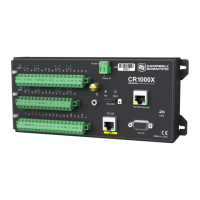l
BrHalf4W()
l
TCDiff()
6.1.2.1 Reverse differential
Differential measurements have the advantage of an input reversal option, RevDiff. When
RevDiff is set to True, two differential measurements are made, the first with a positive
polarity and the second reversed. Subtraction of opposite polarity measurements cancels some
offset voltages associated with the measurement.
For more information on voltage measurements, see Improving voltage measurement quality
(p. 48) and Analogue measurements specifications (p. 166).
6.1.3 Improving voltage measurement quality
The following topics discuss methods of generally improving voltage measurements:
Read More: Consult the following technical papers at www.campbellsci.com/app-notes for in-
depth treatments of several topics addressing voltage measurement quality:
l Preventing and Attacking Measurement Noise Problems
l Benefits of Input Reversal and Excitation Reversal for Voltage Measurements
l Voltage Accuracy, Self-Calibration, and Ratiometric Measurements
6.1.3.1 Deciding between single-ended or differential measurements
Deciding whether a differential or single-ended measurement is appropriate is usually, by far, the
most important consideration when addressing voltage measurement quality. The decision
requires trade-offs of accuracy and precision, noise cancellation, measurement speed, available
measurement hardware, and fiscal constraints.
In broad terms, analogue voltage is best measured differentially because these measurements
include the following noise reduction features that are not included in single-ended
measurements.
l Passive Noise Rejection
o
No voltage reference offset
o
Common-mode noise rejection, which filters capacitively coupled noise
l Active Noise Rejection
o
Input reversal
o
For more information, see Compensating for offset voltage (p. 59).
Reasons for using single-ended measurements, however, include:
6. Measurements 48

